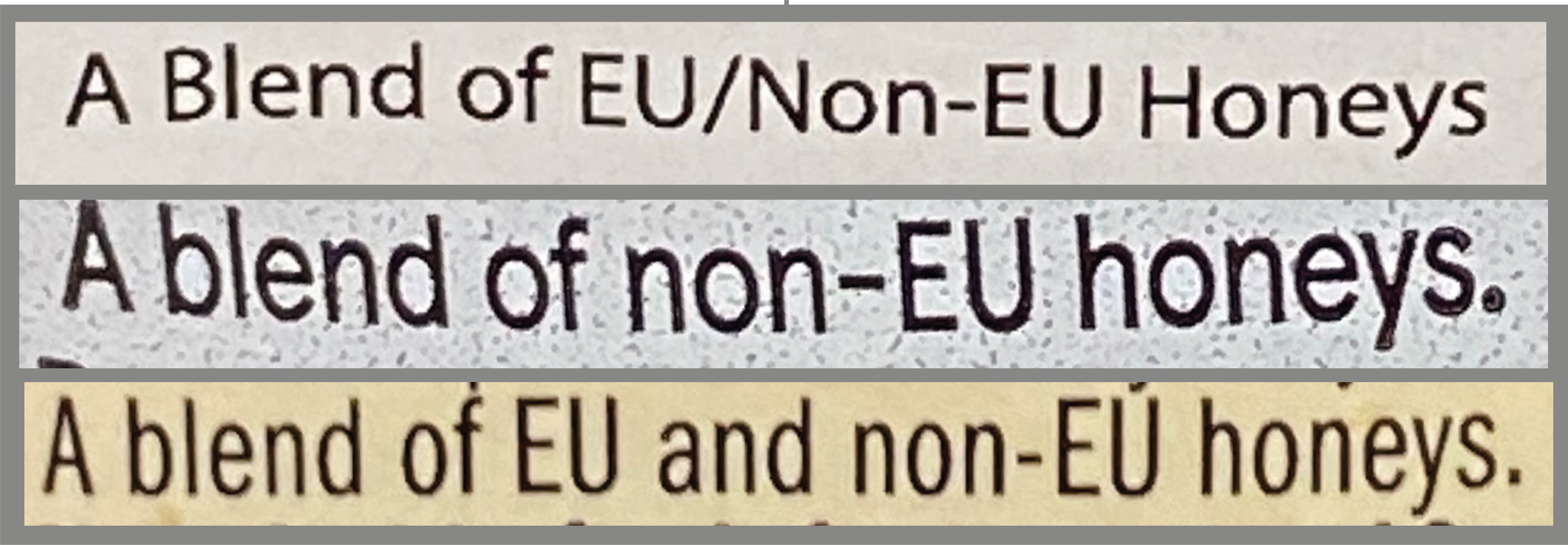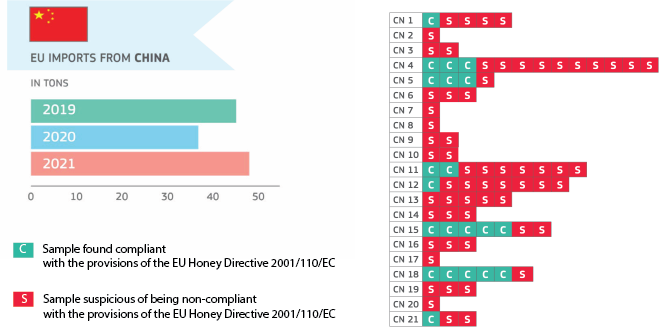Honey 6
Honey Fraud
It is not too difficult to find examples of nondescript honey on the supermarket shelf.

Honey consumption in Europe far outstrips that which can be produced by European beekeepers. Europe is therefore a net importer of honey. However, the quality of this imported honey leaves much to be desired. See for example an article entitled
"Europe is being flooded with fake honey" Euractiv
In this article the words of Walter Haefeker, head of the European Beekeepers’ Association are quoted :
“Most of the honey that you find is labelled blend of EU and non-EU honey – there are no standards. The information on the label tells consumers nothing, except that this honey is not from Mars.”
There is much evidence which points to China as the source of this fake honey. Rice and corn syrups are the main additives. Information on rice syrup for addition to honey is easily accessed on Alibaba.com. Just scroll down the page.
Current EU regulations leave honey producers and consumers unprotected against counterfeit honey imports Pen & Tech
Each local honey contains its own fingerprint of authenticity in terms of the pollen grains it contains. Honey from China is so highly filtered that it is unlikely to contain any pollen which would give it some resemblance of authenticity. So what can be done to safeguard the uniqueness of genuine honey?
MRI Spectroscopy (Magnetic Resonance Imaging) is a new analytical technique being promoted by Bruker as a cost effective method to identify fraudulent honeys. More detailed information on the use of MRI can be read on the Bruker Biospin web site.
"Europe is being flooded with fake honey" Euractiv
In this article the words of Walter Haefeker, head of the European Beekeepers’ Association are quoted :
“Most of the honey that you find is labelled blend of EU and non-EU honey – there are no standards. The information on the label tells consumers nothing, except that this honey is not from Mars.”
There is much evidence which points to China as the source of this fake honey. Rice and corn syrups are the main additives. Information on rice syrup for addition to honey is easily accessed on Alibaba.com. Just scroll down the page.
Current EU regulations leave honey producers and consumers unprotected against counterfeit honey imports Pen & Tech
Each local honey contains its own fingerprint of authenticity in terms of the pollen grains it contains. Honey from China is so highly filtered that it is unlikely to contain any pollen which would give it some resemblance of authenticity. So what can be done to safeguard the uniqueness of genuine honey?
MRI Spectroscopy (Magnetic Resonance Imaging) is a new analytical technique being promoted by Bruker as a cost effective method to identify fraudulent honeys. More detailed information on the use of MRI can be read on the Bruker Biospin web site.
What is being done to combat Honey Fraud in the EU?
The EU has published a paper: EU COORDINATED ACTION : “From the hives” : Sampling, investigations and results
Quoting from this comprehensive paper:
The market for honey in the EU is growing, according to Euromonitor data, from EUR 2.0 billion in 2019 to EUR 2.2 billion in 2020 to EUR 2.3 billion in 20213. With an annual production of 218 000t the EU is the world’s second largest producer (after China). 12% of the world’s honey production comes from the EU. Importing 175 000 t/year, the EU is also the world’s second importer of honey (after the US), representing 30% of the world’s honey imports. With a self-sufficiency of about 60% the EU market depends on imports of honey from third countries. Eight countries account for more than 90% of all EU imports (Ukraine, China, Mexico, Argentina, Cuba, Brazil, Uruguay and Türkiye). The main importing Member States are Germany, Poland, Belgium and Spain. Most of the imported honey is used in blends and marketed in retail under brand names. About 80% of the honeys sold in retail are blends.
The Report gives profiles of exporting countries and of exporters that were subject to sampling during the EU coordinated action. That for China is shown below. It is perhaps not too surprising that most of the samples tested showed up red i.e.
 Sample suspicious of being non-compliant with the provisions of the EU Honey Directive
Sample suspicious of being non-compliant with the provisions of the EU Honey Directive
Quoting from this comprehensive paper:
The market for honey in the EU is growing, according to Euromonitor data, from EUR 2.0 billion in 2019 to EUR 2.2 billion in 2020 to EUR 2.3 billion in 20213. With an annual production of 218 000t the EU is the world’s second largest producer (after China). 12% of the world’s honey production comes from the EU. Importing 175 000 t/year, the EU is also the world’s second importer of honey (after the US), representing 30% of the world’s honey imports. With a self-sufficiency of about 60% the EU market depends on imports of honey from third countries. Eight countries account for more than 90% of all EU imports (Ukraine, China, Mexico, Argentina, Cuba, Brazil, Uruguay and Türkiye). The main importing Member States are Germany, Poland, Belgium and Spain. Most of the imported honey is used in blends and marketed in retail under brand names. About 80% of the honeys sold in retail are blends.
The Report gives profiles of exporting countries and of exporters that were subject to sampling during the EU coordinated action. That for China is shown below. It is perhaps not too surprising that most of the samples tested showed up red i.e.

What is being done to combat Honey Fraud in the UK?
The Report produced a similar chart shown below for UK exports into the EU. Not surprisingly all sample were shown to be
 suspicious of being non-compliant with the EU Directive. So what about the honey which remains and is on sale in the UK?
suspicious of being non-compliant with the EU Directive. So what about the honey which remains and is on sale in the UK?
The UK Government does not appear to be doing anything to combat honey fraud in the UK.
The Report produced a similar chart shown below for UK exports into the EU. Not surprisingly all sample were shown to be
The UK Government does not appear to be doing anything to combat honey fraud in the UK.
